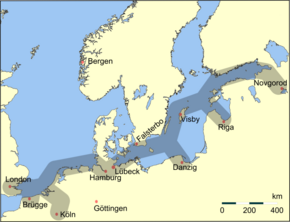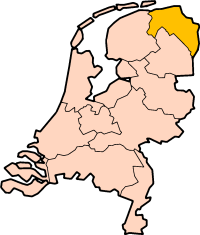Groningen (city)
| Groningen | |||
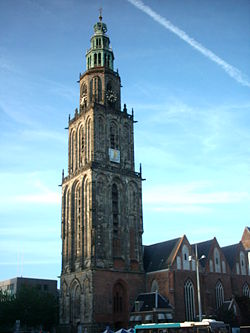 |
|||
|
|||
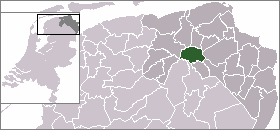 |
|||
| Coordinates: | |||
| Country | Netherlands | ||
|---|---|---|---|
| Province | Groningen | ||
| Municipality | Groningen | ||
| Area (2006) | |||
| - Total | 83.69 km² (32.3 sq mi) | ||
| - Land | 79.59 km² (30.7 sq mi) | ||
| - Water | 4.10 km² (1.6 sq mi) | ||
| Population (1 January, 2007) | |||
| - Total | 181,819 | ||
| - Density | 2,284/km² (5,915.5/sq mi) | ||
| Source: CBS, Statline. | |||
| Time zone | CET (UTC+1) | ||
| - Summer (DST) | CEST (UTC+2) | ||


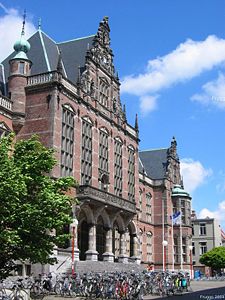


Groningen is the capital city of the province of Groningen in the Netherlands. With a population of 185,000, it is by far the largest city in the north of the Netherlands. Groningen is a university city, in which usually more than 45,000 students are staying.
Contents |
History
The city was founded on the northernmost point of the Hondsrug area. The oldest document referring to Groningen's existence dates from 1040. However, the city already existed long before then: the oldest archaeological traces found are believed to stem from the years 3950 BC–3720 BC, although the first major settlement in Groningen has been traced back to the 3rd century AD.
In the 13th century, when Groningen was an important trade centre, its inhabitants built a city wall to underline its authority. The city had a strong influence on the surrounding lands and made its dialect a common tongue. The most influential period of the city was the end of the 15th century, when the nearby province of Friesland was administered from Groningen. During these years, the Martini Tower was built, which loomed over the city at (then) 127 metres tall, making it the highest building in Europe at the time. The city's independence came to an end when it chose to join forces with the Spanish during the Eighty Years' War in 1594. It later switched sides, joining the Republic of the Seven United Netherlands.
In 1614, the University of Groningen was founded, initially only for religious education. In the same period the city expanded rapidly and a new city wall was built. That same city wall was tested during the Third Anglo-Dutch War in 1672, when the city was attacked fiercely by the bishop of Münster, Bernhard von Galen. The city walls resisted, an event which is celebrated with music and fireworks on 28 August.
The city did not escape the devastation of World War II. In particular, the main square, Grote Markt, was largely destroyed in April 1945, at the Battle of Groningen. However, the Martinitoren, its church, the Goudkantoor, and the city hall were not damaged. The battle there lasted several days.
Art, culture and nightlife
Although Groningen is not a large city, it does have an important role as the main urban centre of this part of the country, particularly in the fields of music and other arts, education, and business. The large number of students living in Groningen also contributes to a diverse cultural scene for a city of its size.
University of Groningen
The University of Groningen (in Dutch: Rijksuniversiteit Groningen) has a rich academic tradition which dates back to 1614. After the University of Leiden, it is the oldest university located in the Netherlands. The university educated the first female student and the first astronaut in the history of the country, the first president of the European Bank and a Nobel prize winner. They share their academic roots with around 200,000 people, who were either students, teachers or researchers at the university.
Museums
The most important and most famous museum in Groningen is the Groninger Museum. With the construction of its current building, designed by Alessandro Mendini, the museum has been transformed into one of the most modern and innovative of its kind in the Netherlands. In addition, the city also has a science museum, a comics museum and a tobacco museum.
Theatre and music
Groningen has its own city theatre (Stadsschouwburg), located on the Turfsingel; a big theatre and concert venue called Martini Plaza; and another major cultural venue on the Trompsingel, called the Oosterpoort. Vera is located on the Oosterstraat, Grand Theatre on the Grote Markt, and Simplon on the Boterdiep. Several cafes feature live music, a few of which specialize in jazz music, including Jazzcafe De Spiegel on the Peperstraat. The jazz music students from the Prins Claus Conservatorium have been known to hold regular jam sessions in cafes such as Peter Pan on the Voor Het Voormalige Klein Poortje and café De Smederij on the Tuinstraat 2-4.
Nightlife
Groningen's nightlife depends largely on its student population. Its cultural scene is vibrant and remarkable for a city of its size. In particular, the Grote Markt, the Vismarkt, and the Poelestraat and Peperstraat are crowded at night, especially on Thursdays and Fridays when some bars do not close until 7 in the morning. In 2006, Groningen was elected "de beste binnenstad" (the best city centre) of the Netherlands.
Partner towns
The city is twinned with the following cities:[1]
 Graz
Graz Jabalya
Jabalya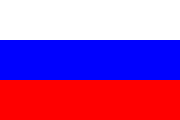 Kaliningrad
Kaliningrad Katowice
Katowice Murmansk
Murmansk Newcastle
Newcastle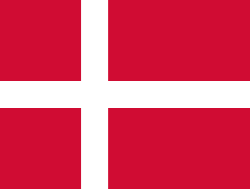 Odense
Odense Oldenburg
Oldenburg San Carlos
San Carlos Tallinn
Tallinn Tianjin
Tianjin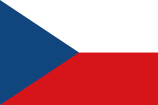 Zlín
Zlín
and in addition with the American state of ![]() Michigan
Michigan
Politics
The city council has 39 members. The left-wing parties PvdA and GroenLinks are the largest. After the elections in 2002, they formed a coalition with CDA and VVD. Jacques Wallage has been the mayor since 1998. As a result of the elections of 2006, three left-wing parties (PvdA, GroenLinks and SP), decided to form a new coalition, which was appointed on April 26, 2006.
Industry
There are two sugar factories within the municipality borders of Groningen, one operated by CSM and one by Suikerunie. The factories produce around 600,000 tonnes of beet sugar annually (2005 figures).
Transport
Groningen has been called the "World Cycling City", since 57% of journeys within the city are made by bicycle. The city is very much adapted to the wishes of those who want to get around without a car, as it has an extensive cycle network, good public transport, and a large pedestrianized zone in the city centre. In the Italian TV program of investigative journalism "Report" appeared a short movie [1], considering the use of bikes in Groningen a good practice to emulate in Italy.
The main train station (served by the Nederlandse Spoorwegen and Arriva) has regular services to most of the major cities in the Netherlands. Direct destinations are:
- Zwolle, Amersfoort, Hilversum, Amsterdam-south and Schiphol Airport (Nederlandse Spoorwegen)
- Zwolle, Amersfoort, Utrecht, Gouda and The Hague (Nederlandse Spoorwegen)
- Leeuwarden (Arriva)
- Winschoten, Leer (Germany)
- Roodeschool and Delfzijl
- Arriva would like to start a new service to Veendam using an old railway in 2009 or 2010.
The A28 motorway connects the city of Groningen to Utrecht (via Zwolle and Amersfoort). The A7 motorway connects Groningen to Friesland and Amsterdam (South-West) and Winschoten and the direction of Bremen in the East.
Arriva run several city buses and interlocal buses. The main routes are:
- 3: Lewenborg-city centre-main station-Vinkhuizen
- 6: Beijum-city centre-main station-Hoornsemeer
- 11: Zernike-city centre-main station
- 39: Groningen-Surhuisterveen
- 50/51: Groningen-Assen
- 61: Groningen-Bedum-Uithuizen
- 82 Groningen-Roden
- 100: Groningen-Drachten-Heerenveen
- 140: Groningen-Appingedam-Delfzijl
- 163: Groningen-Lauwersoog (connecting the ferry to Schiermonnikoog)
- 300/305: Groningen-Borger-Emmen
- 301: Groningen-Veendam
- 315: Groningen-Heerenveen-Lemmer-Lelystad (longest bus route in The Netherlands)
There are also direct buses between Groningen (train station) and Bremen (airport) in Germany, run by Public Express.
In the near future, there are plans to build a tram route connecting the central station, the city centre and the university complex (Zernike).
Groningen Airport Eelde is located 10km south of the centre of Groningen, with scheduled and holiday charter services to European destinations.
Climate
Groningen has a moderate temperate climate, with relative warm summers and cool winters. Weather is influenced by the North Sea to the north-west and its prevailing north-western winds and gales. Winter temperatures are cool: on average above freezing, although frosts are not uncommon during spells of easterly winds blowing in from the inner European continent, i. e. Germany, Russia and even Siberia. Night-time tempuratures of -10 °C or lower are not uncommon during cold winter periods. The lowest temperature ever recorded is -26.8 °C on February 16, 1956. Snow occasionally falls, but rarely stays long due to warmer day-time temperatures. Summers are somewhat warm and humid. Temperatures of 30 °C or higher occur, but most average daytime high's are around 21-24 °C. Very rainy periods are common, especially in spring and summer. Average annual precipitation is about 900 mm.
| Month | JAN | FEB | MAR | APR | MAY | JUN | JUL | AUG | SEP | OCT | NOV | DEC | Year |
|---|---|---|---|---|---|---|---|---|---|---|---|---|---|
| Avg high °C (°F) |
4.6 (41.7) |
5.2 (42.8) |
8.8 (48.6) |
12.4 (54.3) |
17.2 (62.8) |
19.6 (66.6) |
21.6 (70.5) |
22.1 (71.2) |
18.4 (65.1) |
13.7 (57.4) |
8.6 (48.6) |
5.7 (43.7) |
13.2 (56.1) |
| Avg low °C (°F) |
-0.6 (32.9) |
-0.6 (32.4) |
1.4 (36.3) |
2.9 (39.2) |
6.7 (46.0) |
9.3 (50.7) |
11.5 (54.5) |
11.3 (54.1) |
9.0 (50.4) |
5.8 (44.6) |
2.7 (39.0) |
0.7 (35.4) |
5.0 (43.0) |
| Source: [2] | |||||||||||||
Football stadium
The football (soccer) stadium of FC Groningen is called Euroborg. Opened in January 2006, the stadium has 20,000 seats. The former football stadium of FC Groningen is the Oosterpark Stadion (12,500 seats).
Born in Groningen
- Roche Braziliano (ca. 1635), pirate
- Daniel Bernoulli (1700), mathematician and physicist
- Albert Eckhout (1610), painter
- Jozef Israëls (1824), painter
- Hendrik Willem Mesdag (1831), painter
- Samuel van Houten (1837), politician, cabinet minister
- Heike Kamerlingh Onnes (1853), physicist, Nobel laureate
- Johan Huizinga (1872), historian
- Jaap Eden (1873), athlete, world champion in speed skating and cycling
- Julia Culp (1880), mezzo-soprano, the "Dutch nightingale"
- A. W. L. Tjarda van Starkenborgh Stachouwer (1888), last governor of the Dutch East Indies (modern Indonesia)
- Jan C. Uiterwijk (1915), Athlete, Shipping tycoon
- Ida Vos (1931), writer and poet
- Wim T. Schippers (1942), artist, comedian
- Corrie Winkel (1944), athlete, Olympic silver medalist
- Joanna Gash (1944), Australian politician
- Jan Sloot (ca. 1945), inventor, claimed to have invented a revolutionary data compression technique
- Alfred Lagarde (1948), radio deejay
- Pete Hoekstra (1953), American politician
- Gerard Kemkers (1967), ice speed skater and coach
- Stephan Veen (1970), athlete, Olympic field hockey champion
- Rutger Smith (1981), athlete, world championship silver medalist
- Kim Feenstra (1986), model, Champion of Holland's Next Top Model, Cycle 2
Trivia
- The city is nationally known as the "Metropolis of the North" and as "Martinistad" referring to the Martini Tower.
- The city is known as "Stad" in the local dialect, which simply translates as City, because Groningen is the only large city in the province of Groningen.
- Until 2007, in the autumns months, the sugar factory produced a distinct sweet smell that could be detected from most parts of the city. In early 2008, the sugar factory Suiker Unie closed its doors.
- After playing a show here supporting The Waterboys, Irish musician Mic Christopher slipped and consequently died from head injuries.
See also
- Battle of Groningen
- Jewish Groningen
- Siege of Groningen
References
- ↑ Partner towns on the city web site.
External links
- Travelguide to Groningen from Wikitravel
- Bus lines (PDF)
- CSM sugar
- Groningen Official Website
- Groninger Museum
- Publicexpress bus line
- Tourist information
- Map of Groningen
- University of Groningen
- Vera - club for the international pop underground
- Webcam - shows Oude Ebbingestraat
- Second World War History
- Groningen on Google Maps
- 360° Fullscreen panoramas from Groningen
|
||||||||||||||||||||||||||
|
|||||||||||
|
|||||||||||||||||



